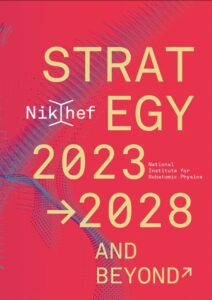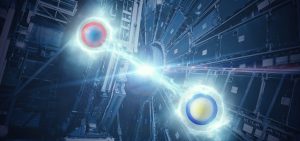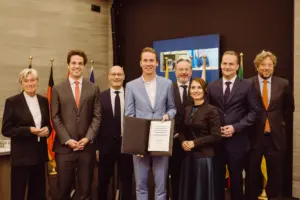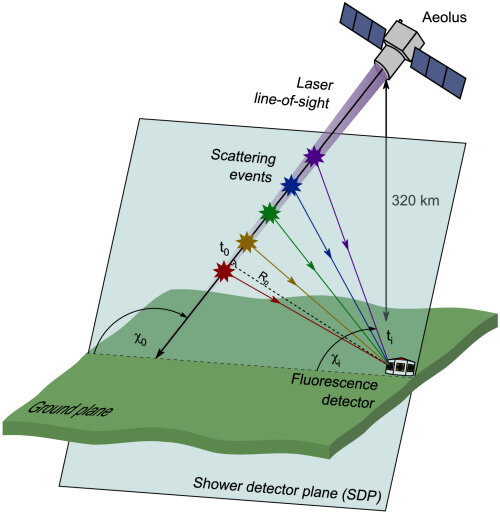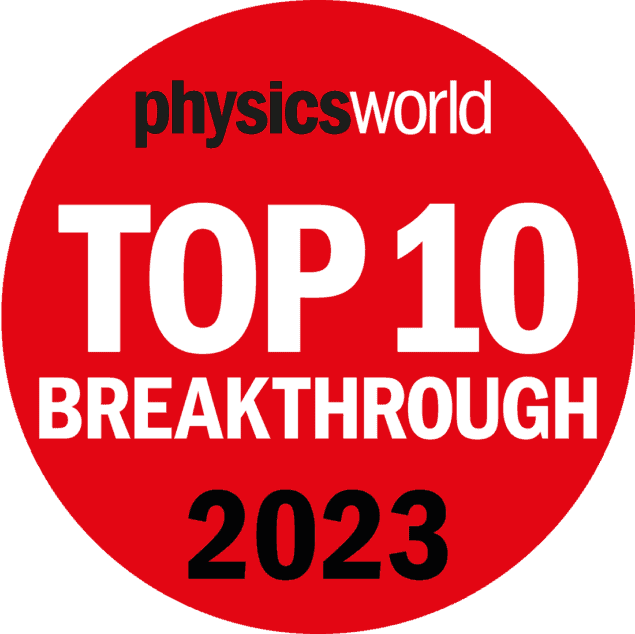2023 at a glance
The Lab
The renovation of the Nikhef building at Amsterdam Science Park is nearing completion after two and a half years. The new central hall, named Vertex, was handed over to Nikhef by the building company on October 26. The renovation included new technical installations, a relocated entrance, and a new central hall with meeting spaces and a lecture hall. Some finishing touches remain, but most staff will return to their offices soon.
The CERN Council has decided to end its cooperation with Russia and Belarus in 2024, following the expiration of international cooperation agreements with these countries. The decision, influenced by Russia’s invasion of Ukraine with Belarus’s involvement, means all relations with institutions in these nations will cease on June 27, 2024, for Belarus and November 30, 2024, for Russia. However, individual collaborations with scientists from these countries will continue.
The new Nikhef Strategy for 2023-2028 focuses on impactful contributions to international subatomic physics. Priorities include expanding knowledge, delivering technology, preparing for future challenges, and fostering collaboration. Research will focus on the Higgs boson, quarks, neutrinos, dark matter, and gravitational waves, with increased use of AI and quantum computing. The strategy also highlights environmental goals and enhancing the organizational culture. The full document and evaluation report are available online.
LHC Physics
In 2023, the LHC experiments provided a wealth of precision results. Examples include measurements of unrivalled precision of the mass of the top quark and of the Higgs boson in several decay channels, determination of the intensity of the strong force at the Z-boson mass scale with an uncertainty of less than 1%, new ultra-precise measurements of the different behaviour of matter and antimatter and the observation of key features of quark–gluon plasma.
Moreover, the ATLAS experiment at CERN has for the first time observed quantum entanglement at high energy levels. Researchers, including those from Nikhef, studied pairs of top quarks produced in proton collisions. These findings confirm Einstein’s theory of “spooky action at a distance” at unprecedented energy levels, showing clear entanglement effects in the spatial distribution of particles from decaying top quarks.
The LHCb experiment has improved the precision of measurements related to matter-anti-matter asymmetry.
For the first time, lead nuclei are circulating in the LHC accelerator at CERN at the highest energy levels. These lead beams, reaching 557.6 TeV per nucleus, are primarily for the ALICE detector to study the quark-gluon plasma, but ATLAS and CMS are also analyzing the collisions. This marks a significant milestone, as the LHC typically accelerates protons. The early start of lead experiments this year follows an incident that required repairs over the summer.
Astroparticle Physics and Theory
Belgium, the Netherlands, and North Rhine-Westphalia are forming a consortium to establish the Einstein Telescope in the Euregio Meuse-Rhine region. During the ET Ministers Conference in Brussels on September 26, 2023, representatives signed an agreement outlining responsibilities and collaboration. This follows a 2022 agreement in Bonn to create a task force for cross-border cooperation. The consortium aims to solidify preparations and submit a bid for the telescope, with support from government, knowledge institutions, and businesses.
The Virgo detector in Pisa will resume its gravitational wave observations in March 2024, aligning with the LIGO detectors in the US. Despite missing the current O4 observation cycle due to sensitivity issues, recent hardware improvements have enhanced its performance. Virgo aims to achieve a sensitivity of 60 Mpc but will participate in the O4 program with its current sensitivity of 35 Mpc. Nikhef researchers significantly contribute to Virgo’s operations and data analysis.
Deployment of a detection unit at the KM3NeT-ORCA site, 40 km offshore from Toulon. Nine new detector lines were installed at the KM3NeT neutrino telescope’s Italian site, bringing the total to 28. These lines are positioned at 3.5 kilometers depth in the Mediterranean Sea, off the coast of Sicily. The KM3NeT project, in which Nikhef plays a leading role, aims to create a large network of light sensors to study neutrinos. The Italian section, ARCA, focuses on identifying neutrino sources, while the French section, ORCA, studies neutrino behavior.
Thanks to the extraordinary cooperation between the space mission Aeolus and the Pierre Auger Collaboration, it was possible, for the first time, to measure a laser beam emitted from space by an Earth-based observatory. The laser transmitter was part of the first spaceborne Doppler wind lidar ALADIN (Atmospheric LAser Doppler INstrument), which was launched in August 2018 on board the ESA Aeolus satellite. The fluorescence detector of the Pierre Auger Observatory was able to detect the laser beam when Aeolus flew over the measurement area.
XENONnT completed its first science run (SR0) with a collected exposure of 1.1 tonne-year. The lowest background level ever achieved with this kind of detector, allowed for the most sensitive search for solar axions, bosonic Dark Matter and WIMP search. With the subsequent longer science run (SR1), XENONnT improves upon those results, and enables the possibility of directly observing, for the first time, interactions of solar neutrinos. Recently, the performance was boosted by doping water with Gadolinium, gaining more sensitivity to ultra-rare processes involving Dark Matter and neutrino physics.
Steve Jones, a physicist at the Van Swinderen Institute of the University of Groningen, partner of Nikhef, contributed to the Alpha-g experiment at CERN, which showed that antimatter falls at the same rate as regular matter. Jones played a crucial role in building the setup for this measurement, marking a significant milestone in physics. His work in Groningen focuses on new techniques to measure hydrogen and antihydrogen simultaneously, aiming to eliminate systematic errors and improve measurement precision.
